… That afternoon.
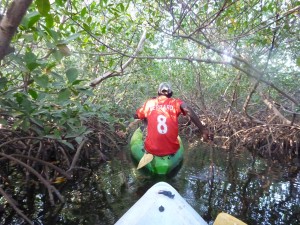
Famara guides us through the mangroves. Pat shares a kayak with him. Markus and I follow them through the maze of mangroves. Roots reach into the water like fingers and we forgo the paddles to pull us along the roots. We emerge and scare a half dozen pelicans. The smell is fresh and salty and the water is tilde and ocean cool and refreshing. Another maze. Small fish jump and we reach a tidal flat. Fiddler crabs scurry into their holes. Behind it the land rises enough for grass and trees. They grew rice here once and then experienced drought. Ten years ago there were twenty five species of fish in these waters. Now there are eighty three. We are in Bamboung. Ecotourism run by Oceanium, a Senegalize conservation organization. Senegal, like most places on earth, suffers from over-fishing. By partnering with the 14 local villages they created a reserve that looks after the mangroves and uses ecotourism as the primary money maker. providing jobs for the locals including enough to pay for locally run patrols to keep illegal fishing to a minimum. Click for video and more photos:
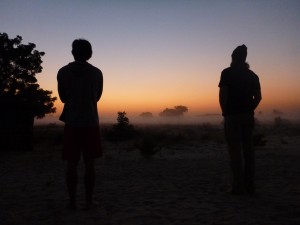 Before dinner we meet the only other guest here, a French woman named Emmanuel. We play bouls in the fading light on the fine grained sand. She said she was here ten years ago and that she was one of the people that made this happen. Her family had been in Senegal for 45 years. She had been gone for 7 years sailing around the world. She had come back just for two nights to see if it was still around. I asked if she was happy with the result. She was. But the 1000 fruit trees she had helped plant had not taken root. Perhaps they would plant a thousand more. Dinner was in a large open hut. It was meat in a red sauce that reminded me of a mix of New Mexican red chili and something else. With a full belly and nothing but a clear half moon floating above us, it was easy to be tired. The sand now felt like cool white flour between our toes. Above us the stars were as clear and bright as I have seen on land. No where on the horizon could I see the glare of any ambient light. To the West, a streak of white light caught my eye. It blazed on and on crumbling apart into two jets of red before disappearing.
Before dinner we meet the only other guest here, a French woman named Emmanuel. We play bouls in the fading light on the fine grained sand. She said she was here ten years ago and that she was one of the people that made this happen. Her family had been in Senegal for 45 years. She had been gone for 7 years sailing around the world. She had come back just for two nights to see if it was still around. I asked if she was happy with the result. She was. But the 1000 fruit trees she had helped plant had not taken root. Perhaps they would plant a thousand more. Dinner was in a large open hut. It was meat in a red sauce that reminded me of a mix of New Mexican red chili and something else. With a full belly and nothing but a clear half moon floating above us, it was easy to be tired. The sand now felt like cool white flour between our toes. Above us the stars were as clear and bright as I have seen on land. No where on the horizon could I see the glare of any ambient light. To the West, a streak of white light caught my eye. It blazed on and on crumbling apart into two jets of red before disappearing.
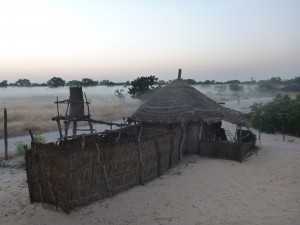 Our digs were composites of a concrete slab and three foot walls of brick. The rest of the walls and roof were thatched. Inside were solar powered lights, a sink, shower, and western toilet. By dawn the concrete and brick that had absorbed the heat of day had finally worn off and it was genuinely cool. In shorts and a t-shirt, Markus and I ran the sandy donkey cart track back to the village as the sun started to rise. The terrain dipped gently in and out of cool and warm air. Low fog hung just above our heads, and the long grass – almost that high – was thick with dew and hung into the path, bursting as we brushed passed it.
Our digs were composites of a concrete slab and three foot walls of brick. The rest of the walls and roof were thatched. Inside were solar powered lights, a sink, shower, and western toilet. By dawn the concrete and brick that had absorbed the heat of day had finally worn off and it was genuinely cool. In shorts and a t-shirt, Markus and I ran the sandy donkey cart track back to the village as the sun started to rise. The terrain dipped gently in and out of cool and warm air. Low fog hung just above our heads, and the long grass – almost that high – was thick with dew and hung into the path, bursting as we brushed passed it.
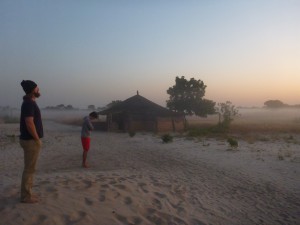 The tide was low after breakfast and Famara took us through a walk in the mangroves. Where we had kayaked yesterday was now just below our knees. Famara told us there are three types of mangrove trees: a white one, and two red ones. One of the reds is taller and more tree like, the other more bushy. What makes them special is a series of adaptations to deal with the salinity including a symbiotic relationship with sea sponges and shedding salt through their leaves. The water is clear and cold. Branches shade us in a green tunnel and long finger like roots stick into the sand and keep land from being eroded by absorbing the waves and storm surges. Many of the fish that make it into the sea start their lives as minnows protected within these fingers.
The tide was low after breakfast and Famara took us through a walk in the mangroves. Where we had kayaked yesterday was now just below our knees. Famara told us there are three types of mangrove trees: a white one, and two red ones. One of the reds is taller and more tree like, the other more bushy. What makes them special is a series of adaptations to deal with the salinity including a symbiotic relationship with sea sponges and shedding salt through their leaves. The water is clear and cold. Branches shade us in a green tunnel and long finger like roots stick into the sand and keep land from being eroded by absorbing the waves and storm surges. Many of the fish that make it into the sea start their lives as minnows protected within these fingers.
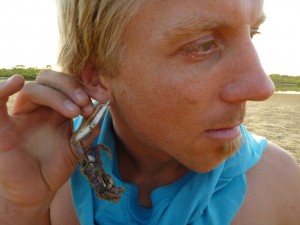 Famara motioned us to stop and be quiet. Crabs scurried through the water. Every few seconds something clicked like the sound of a castanet. This is the sound of oysters attached to the roots breathing at low tide. Through the watery paths we find ourselves in a wide open tide flat. Neat rows of baby mangroves have been parted. French and American organizations like the Peace Corps have sent volunteers to help plant them. It looked like a lot of work. I wonder how many of these will make it to maturity.
Famara motioned us to stop and be quiet. Crabs scurried through the water. Every few seconds something clicked like the sound of a castanet. This is the sound of oysters attached to the roots breathing at low tide. Through the watery paths we find ourselves in a wide open tide flat. Neat rows of baby mangroves have been parted. French and American organizations like the Peace Corps have sent volunteers to help plant them. It looked like a lot of work. I wonder how many of these will make it to maturity.
In the heat of day we wander into the cool water and swim to another tidal flat a stone’s throw from our huts. The tide here does not lap but rather gently rises above the sandbar. Small rays flit away from our feet. Birds swoop down above the fish and they leap out of the shallow water. It gives me an idea. I walk back to the still exposed sand and put the rising water between me and Pat. I start to run. As soon as my feet hit the water dozens, if not a hundred silver four inch fish fish leap ahead of me. This is about the most exciting thing to do at Bamboung and I think its perfect that way.
